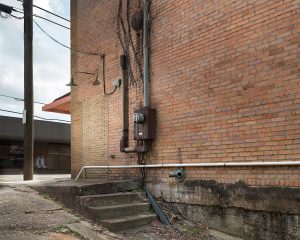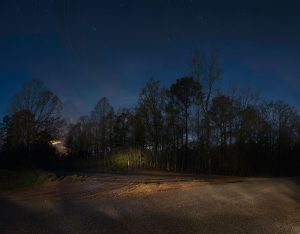
Rich Frishman, Colored Entrance, Tylertown, MS, 2018, Archival inkjet print, Promised gift of an anonymous donor
Photographer Rich Frishman has traveled much of the American South in recent years documenting the haunting physical reminders of a region where racial segregation was the social norm and enforced law until recent decades. His photographs include the erased-but-visible former “colored entrances” of movie theaters, bus stations, and other public spaces, along with former separate schools for black students in the era before the Brown v. Board of Education ruling, and the grounds where mob violence led to lynchings. Frishman’s photographs are included in the exhibition You Are Here: A Brief History of Photography and Place, on view through July 28, 2019.
How did your Ghosts of Segregation series come about?
I’ve long been fascinated by how our vernacular landscape reveals our cultural priorities and proclivities. In my previous project, American Splendor, I explored more amusing aspects of this human topography. I felt an affection for many of these places: restaurants in the shape of giant fish, grain silos painted like Budweiser cans, the American Gothic couple rising as sculptures above the Iowa State Fairground. About two years ago I experienced a trauma that caused me to reassess this nostalgia. I found myself casting a more critical eye at what our built environment revealed about our society.
I was photographing in Gonzales, Texas, in March of 2016 and stumbled upon what was, to me, a shocking vestige of our America — a segregation wall in Templin’s Saloon. It had been retained by the proprietor as a reminder of darker times. My local guide described how his own grandmother had to sit on the backside of that wall until the mid-1960’s. As I set about documenting this ghost of Jim Crow, I was keenly aware that the nearby big-screen TV was broadcasting US Senator Mitch McConnell speaking about obstructing the nomination of Merrick Garland to the Supreme Court. It struck me that these ghosts are are very much alive.
That is when I began actively seeking to document vestiges of segregation and the struggle for equality.
How do you locate the sites that display vestiges of segregation from the past?
I find my locations much like I find my inspiration, by talking with people who have different experiences than me, by reading broadly, and by searching the internet for locations. I at least scan the New York Times and Washington Post every day, and I read articles on such sites as blacklist.org, eji.org, and an assortment of historical preservation websites. Here in New Orleans, you have the absolutely amazing Historic New Orleans Collection and their Williams Research Center, which are world-class resources.
Since I am a photographer, I also research what each potential location actually looks like, what time of day and year might be most favorable, and how it juxtaposes with its physical context. To do this, I often get in the Google helicopter, also called Google Earth, for a quick flyover, then I get in the Google car — street view — and drive by. There are times when I get to a new town and feel like I’ve been there before, just because I’ve driven up and down the streets so many times online. In fact, I’ve found some of the locations just going for a virtual drive.

Rich Frishman (American, b. 1951), Lynching Site of James Chaney, Mickey Schwerner, and Andrew Goodman, Neshoba County, Mississippi, 2018, Archival inkjet print, Gift of an anonymous donor
Two of your photographs are currently on display at NOMA — one of a bricked-in movie theater entrance in Tylertown, Mississippi, and another of the infamous murder location of three civil rights workers in Neshoba County, Mississippi. Can you describe how you framed these works, and anything that you found particularly nuanced about them?
The Tylertown segregated entrance is one location I found via a virtual drive in Google street view, but the details of the alley were not apparent until I was standing there. I was struck by the decrepitness of the scene, the tangle of vines and wires and rusting metal, the angle of the alley as it descended from the sidewalk, the detritus and debris that people once had to navigate to simply see a movie. I wanted to document this humiliation in granular detail, to make the texture of this bricked-over wound feel three-dimensional.
The scene at the crossroads of County Roads 515 and 287 outside Philadelphia, Mississippi, was particularly challenging and important to me. In 1964 I was 13 years old, and I can still remember the tragedy unfolding. James Chaney, Andrew Goodman, and Mickey Schwerner were heroes to me, and they still are. I view the location of their murder as hallowed ground, and I wanted to document it in a fashion that might convey some of what they saw in those final moments. I will never know what they truly experienced, but I know how standing there made me feel: awed, frightened, guilty, and saddened. While I had scouted the location in the light of day, I wanted to represent the scene at the time of their execution. Much as it would have been that night in June 1964, the scene is lit by car lights and moonlight. Even the phase of the moon is almost identical. The starry heavens are, for me, a counterpoint to the hell below.
See more of Frishman’s Ghost of Segregation series and other works at his official website.